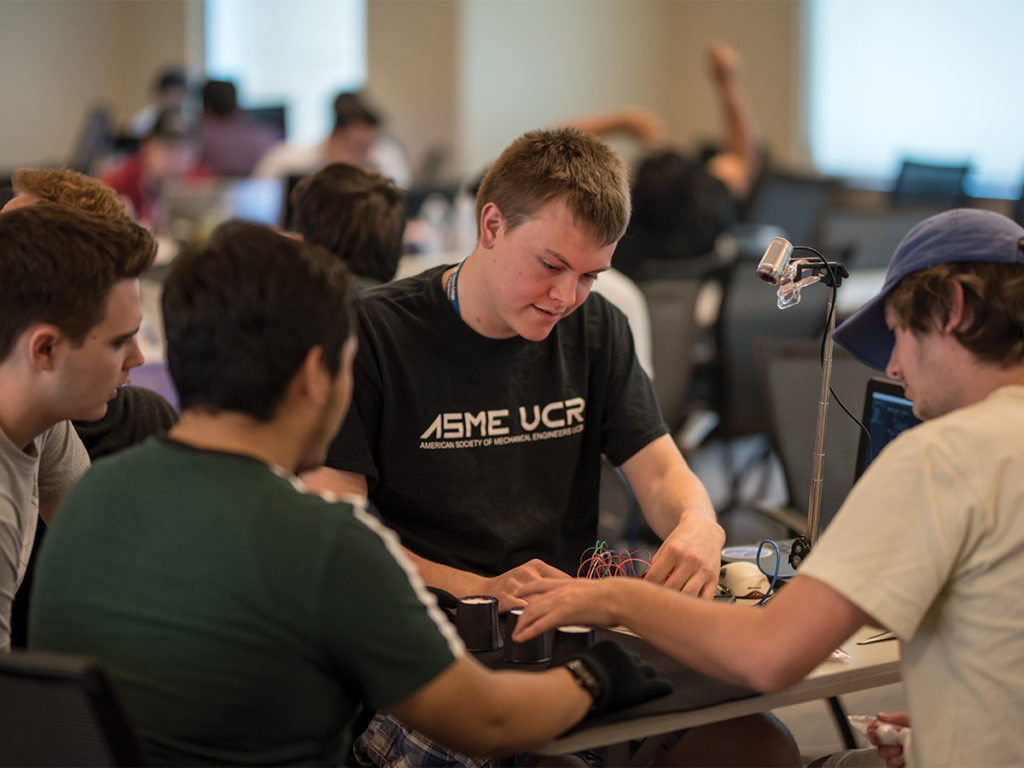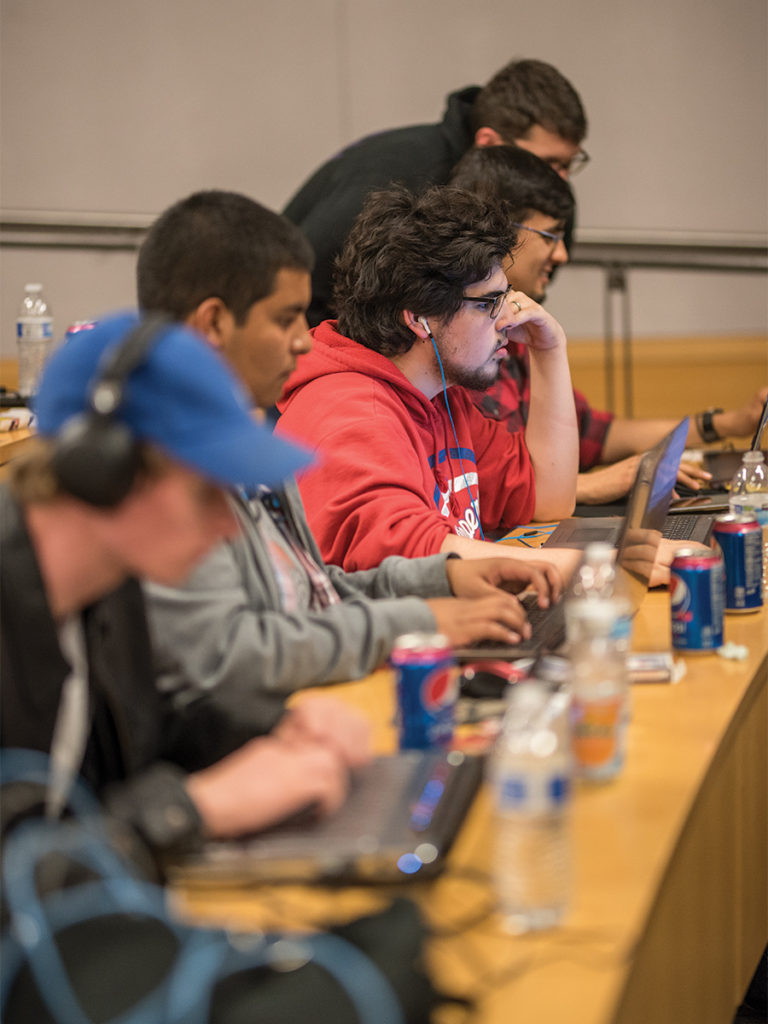Starting at 8 a.m. on Saturday, May 20, around 200 college students from UCR and surrounding community colleges gathered at Winston Chung Hall for the fourth annual Cutie Hack. Filled with both returning and brand new competitors, students from UCR, Rio Hondo College, Moreno Valley Community College and Riverside Community College were ready to duel to create the most entrepreneurial, complete and functional software and hardware.
Hosted by the Association for Computing Machinery (ACM) at UCR and the Institute of Electrical and Electronics Engineers (IEEE), Cutie Hack is one of the two hackathons that occur on UCR’s campus, the other being the Citrus Hack that the two on-campus organizations also sponsor during fall quarter. The difference, according to organizer and second-year computer science major Audrey Der, is that “Citrus Hack lasts for 36 hours and is much larger and more inclusive, whereas Cutie Hack is more beginner-friendly because it’s smaller scale and there are fewer things you can make in 12 hours.” As soon as one of the hackathon ends, coordination for the next begins (applications for Citrus Hack opened right after the winners of this year’s Cutie Hack were announced).
Being attentive to new engineers, programmers, designers and scientists, the Citrus Hack had two components: Educational and competitive. “Many students enter without knowing what to do or who their teams are,” revealed director and second-year computer science major John Pham. “We hold workshops so that students can learn and have ideas tossed around, and it can also be an opportunity for people to meet others and form teams. The competitive aspect is that everyone is competing for five title places: Best hardware, best entrepreneurial, best beginner, second-place and first-place hack.” In order to gain more insight into the building process and team efforts of Cutie Hack, The Highlander chose two random teams — one software and one hardware — to shadow throughout the event.
After registration was finalized, hacking officially commenced at 9 a.m., and the hardware and software teams were divided into different rooms. On the second floor of Winston Chung Hall was where the hardware teams assembled. One of the hardware teams consisted of Jack Kolb, first-year mechanical engineering major, Jason Mendoza, first-year computer science major, Ryan Pecor, first-year computer science major, and Nick Ray, first-year electrical engineering major. What they aimed to create was a hardware system that could track one out of three cups that held an object beneath it. They did so by first placing the white cups on a black felt surface and installing a paint program that could isolate the white pixels (which have equal and high amounts of red, green and blue). Once the system tracked the cups, indicated by “A,” “B” and “C,” they were designated their own positions: “X,” “Y” and “Z.” Kolb explained, “We can track of each cup by comparing each cup with the position that travelled the least amount of distance with every movement.” The team, all of whom met each other in the Lothian engineering hall, had been working on this idea for up to a month.

Jimmy Lai/HIGHLANDER
Meanwhile, the software teams convened in the Winston Chung Lecture Hall. One of them was a group of four students from Rio Hondo College: Computer science graduate students Alfredo Sanchez-Mendoza and Lucca Andrade Guedes Galvao Coutinho, first-year computer science major Thomas Carrillo and second-year computer science major Reiley Marsh-Bogy. They were designing a video game with 27 levels that Coutinho described as being “very basic but it will be impressive enough to have a finished product … Each level has its own objective, which is saving someone.”
The team was organized by allocating assignments to each member, with Sanchez-Mendoza working on the design, Coutinho on the intelligence of the enemies in order to make the game challenging, Carillo on the sound and Marsh-Bogy on scripting. They claimed that their motive for joining the hackathon was mainly to test the waters of computer science to see what it has to offer, such as Sanchez-Mendoza, who earned his degree in computer science and is interested in pursuing a career in architecture. The team working behind them, who went by the team name, “The Beautiful People,” and consisted of computer science graduate students Vu Nguyen, Jesus Osuna and Antonio Guzman, also attended Rio Hondo College and were close friends with the quad.
They were working on an interlinking software that could instantly link users up with language teachers from around the world and compared their system to a “tutoring version of Uber,” as described by Osuna. Guzman and Osuna were bringing forth the application to Cutie Hack because they were encouraged to do so by one of their professors, whose friend would potentially hire them for their idea. 26-year-old Nguyen, on the other hand, originally worked in the medical field after college, but following the death of his cousin, who was a computer science major, he felt inspired to return to college to study computer science instead and “one day be able to read my cousin’s thesis that’s lying on my desk right now.”
By the time 3 p.m. rolled around, both the hardware and software teams had built enough of their projects to be smooth-sailing — or so they thought.
After getting their machine to work, the hardware team was developing an algorithm to fix the bugs in the program, like the machine confusing one cup with two numbers. The program was coded using Python, but out of all the team members, Kolb was the only one who knew how to code in Python while the others knew coding in C++. “It’s not a language barrier but more of a dialect barrier,” commented Pecor.
While Pecor and Mendoza submitted their project, Kolb searched for glitches in the coding. For example, one of their lists within their coding showed an error when finding the x-location. To fix it, they went through the coding and looked for the function that finds duplicates and readjusted it to accommodate. Additionally, the team also had to add the signal so that it knows to stop tracking and how to determine where the ball is.
Meanwhile, the software team had finished creating artificial intelligence, animations and players. Their next challenge was to bring it all together within the two hours they had left. While dividing work helped the team get much more done, it ended up being a struggle at the end to bring all their work together. One major problem they encountered when transferring their work to another computer was when the player fell through the world that was designed in another computer. They also decided to create a user interface which would give player information during the last two hours in the hackathon. To fix the problem, they had to look at their coding to see where they went wrong.
Back with the hardware team, to not move the cups out of range, the team placed electrical tape on the borders of the mat. They had also changed the shuffler, the person who would be moving the cups, to be Kolb. The team had discovered that to stop it from glitching, they had to slowly move the cups without covering the tops from the camera.
After testing out their project, the hardware team was excited that their project was functioning correctly: Numbers weren’t getting mixed up with each other and the machine successfully tracked the cup which had the ball under it. But the software team was under pressure working to put everything together within the last hour. The team was waiting for the characters to be completed before they could start assembling the game. Out of the planned 27 levels, only three would be possible to put together before the time ran out. “Designing a user interface in the last hour wasn’t a good idea. I didn’t know it would take that long,” shared Marsh-Bogy.

Jimmy Lai/HIGHLANDER
While putting everything together in the last hour, level one did not show any colors after being transferred to another computer. Their quick attempt to fix it involved finding the codes used for color on the other computer and using them to add color. Level two was able to work, and it replaced what would have been level one. Coutinho stated, “I tried to do attack (coding) by myself and it took an hour. That was our demise.” The software team managed to get their program finished but missed the 9 p.m. deadline, therefore disqualifying them for the closing ceremony presentations.
The closing ceremony took place in the Winston Chung Lecture Hall. The panel consisted of seven judges, all of whom are UCR alumni and now members of the technology industry (with the exception of LePendu): Brian Ho, a software engineer at Meggitt, Kevin Yang, also a software engineer at Meggitt, Manny Sanchez, a software engineer at Google, Miguel Martinez, a software developer at Guidance Software, Paea LePendu, an associate research professor at UCR, Pratap Rao, an associate equities trader at Morgan Stanley and Vinci Sevilla, a project manager at Southern California Edison.
Kolb, Mendoza, Pecor and Ray’s team presented second out of the roughly 30 teams (out of the 50 total that participated in the event) but unfortunately could not get the tracking system to run properly during the presentation.
However, their project was still impressive considering that a majority of the projects were software-run, which generally are more reliable. These ranged from ideas that were both practical and far-out: A twin-differentiating generator, campus classroom navigator, map that listed ideal places to nap around your area and notification bot via Twitter. Only a few other hardware projects were presented, one of which belonged to the Citrus Hack 2016 first-place winner and first-year engineering major Spyridon Catechis. His invention was a HEX code-based mogul that could track data from a textbook page using an electrode placed above the eye. The judges asked all of the teams questions not only related to the technicalities of the projects but their potential in the market, the roles each member had, whether or not if they were beginners and the biggest challenges they faced during the event.
The planned ending time of the closing ceremony was 11 p.m., but the presentations went overtime by about 20 minutes, and the judging portion took an additional 20 minutes. For a much-needed wake up and stretch break, director and second-year computer science major Jacob Poole led an adrenalizing “Simon Says” game, and one of the software projects titled R’Music, which was a music performance game similar to Guitar Hero that could visually recreate the notes from an audio file, was displayed on the screen after.
When the judges finally returned, everyone returned to their seats and listened intently for the results to be revealed.
The Best Hardware Hack award was given to an automated Bluetooth bike lock that was built using only hardware and two Starbucks cups, which the judges explained were worthy of the title because of the way the team “worked together, presented it thoroughly and got it to work.”
The Golden Bear Claw game was text-based. We wanted to do what they did but more advanced, but theirs worked. So I actually find lots of inspiration in them.
The Best Beginner Hack was given to Golden Bear Claw, a purely text-based game that was inspired by Indiana Jones, which the judges described as being “very complete … (and) the team did not overestimate their abilities.”
The Best Entrepreneurial Hack, which the judges said had the greatest application to the real world, was awarded to UCR Maps, which helped navigate students throughout the campus and to their classrooms.
Second place went to Breathless Endless Runner, a game which the team compared to Temple Run and consisted of many different shapes along a fast-moving path that the user had to avoid.
Finally, with what was described by the judges as being the most complete and holding the most functionality out of all of the projects, Parkbnb was titled the first place winner. It was an application that allowed users to rent out parking spaces to other users as well as finding the cheapest places to park nearby. The application also displayed pictures of the parking spaces similar to what Google Maps does when you click on a location.
After briefly discussing the After Cutie Hacks event, which will take place this Monday, May 22 and allow teams to “take their projects to the next level and possibly to the market,” as stated by Pham, applications for Citrus Hack opened, and the event officially adjourned.
From the software group The Highlander followed throughout the event, Coutinho revealed what went wrong with their project but also expressed optimism for future hackathons: “We had too many goals we couldn’t reach with the deadline we had. The Golden Bear Claw game was text-based. We wanted to do what they did but more advanced, but theirs worked. So I actually find lots of inspiration in them.” Carillo shared an anticipation for his future in computer science following the event, saying, “Next time, I want to stay more focused, but now after seeing all of the programs that I can build, I want to make everything.”
The hardware group we tracked, who came out of their first hackathon without a title but with a finished project, shared similar sentiments as the software group. Kolb voiced how he could improved the team’s presentation in the future by having a video demo in the case that the project does not function during the judging demonstrations and that they could make a more entrepreneurial project since theirs was “very theoretical.” He expressed his interest in going into the field of robotics and artificial intelligence and, although very difficult, he could imagine applying the skills he used during Cutie Hack to those concepts in the future. Ray proclaimed, “The event was very fun,” to which Mendoza added, “It was a great experience even though our project didn’t work. I think we had our own victory.”








